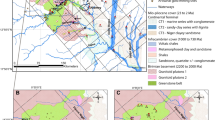Abstract
Water resources near a gold-mine waste site were studied for the distribution and contents of contaminants, and their behavior in the surface and groundwater systems. Arsenic, cadmium, and manganese were identified with levels exceeding the drinking water guidelines of WHO (World Health Organization), and their distribution depended upon the differences in source materials and in spatial pH variations. Originating from arsenopyrite, concentrations of dissolved arsenic were controlled by sorption with amorphous iron (Fe(OH)3) and carbonate minerals. Cadmium and manganese were derived from the mineral phase including sphalerite (ZnS), otavite (CdCO3), and rhodochrosite (MnCO3); their concentrations in water resources were limited by the solubility of mineral phases. All of these processes are significantly pH-dependent, implying that a small decline in pH could result in a drastic increase in contaminant concentrations and become a pollution threat to the water resources of the Gubong area.
Similar content being viewed by others
Author information
Authors and Affiliations
Additional information
Received: 13 December 1999 · Accepted: 21 March 2000
Rights and permissions
About this article
Cite this article
Woo, N., Choi, M. Arsenic and metal contamination of water resources from mining wastes in Korea. Environmental Geology 40, 305–311 (2001). https://doi.org/10.1007/s002540000161
Issue Date:
DOI: https://doi.org/10.1007/s002540000161




